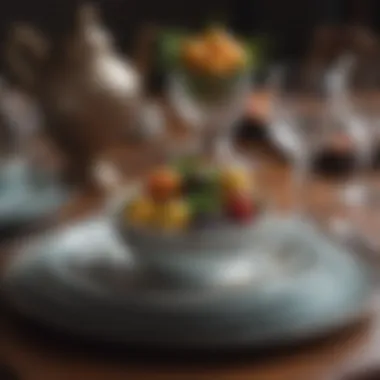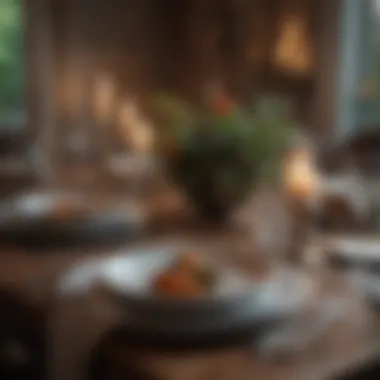Mastering the Art of Dinner Table Setting


Intro
Setting a dinner table is more than just a practical necessity; it’s an art form that merges aesthetics with hospitality. The way a table is laid not only influences the ambiance but also sets the tone for the entire dining experience. From the meticulous selection of tableware to the subtle placement of decorative accents, each element plays a vital role in crafting an inviting atmosphere. This guide aims to delve into the nuances of table setting, exploring how to harmonize beauty and function effectively.
Whether you’re hosting an intimate dinner for friends or an elaborate soirée, understanding the principles behind table setting can elevate your event from ordinary to extraordinary. Creating a table that captivates guests requires thoughtfulness and creativity, weaving together various components to forge a cohesive look. With a pinch of inspiration and a sprinkle of etiquette knowledge, you’ll be on your way to impressing your guests with a beautifully arranged dinner table.
Understanding the Importance of a Well-Set Table
Setting a table isn't just about placing plates and cutlery. It's an art that reflects care, thought, and a little bit of personality. When one processes dining through the lens of aesthetics and function, it becomes evident how a well-set table can enhance not just the meal but the entire gathering experience.
The Role of Aesthetics in Dining Experiences
Aesthetics play a crucial part in dining. When the table is visually pleasing, it captures attention right from the moment guests arrive. Imagine entering a dining room where soft candlelight dances across polished silverware and colorful dishes. That sense of anticipation, coupled with a warm ambiance, sets the stage for what is often an intimate shared experience.
- Visual Impact: A well-set table draws the eye. Beautiful colors, textures, and arrangements can create a feast for not just the stomach but also the eyes.
- Influence on Mood: Soft lighting, fresh flowers, and carefully chosen tableware can shift the atmosphere significantly. Dining becomes an occasion—a reason to pause and connect.
- Cohesive Design: The table is like a canvas. It can showcase a theme, whether you opt for rustic elegance, modern minimalism, or festive exuberance. Everything can harmonize or contrast beautifully, adding layers of depth to the experience.
In essence, a restaurateur would hardly plate a dish on an unkempt table; similarly, thoughtful hosts understand that a well-set table enhances the overall enjoyment.
Cultural Significance of Table Settings
Table settings carry deep-rooted cultural meanings, shaped by centuries of tradition and etiquette. For many cultures, the table is a symbol of hospitality, respect, and unity.
- Customary Practices: Different regions have unique traditions, like how an Indian thali not only serves food but showcases the vastness of flavors. In contrast, a French table might feature multiple courses served in succession, each with careful consideration of presentation.
- Symbol of Togetherness: Families often gather around the table for meals—it's a meeting place for stories, laughter, and shared moments. The arrangement, the specific items chosen, and even the utensils hint at deeper connections.
- Rituals and Ceremonies: Special occasions, like weddings or holidays, often involve elaborate table settings representative of cultural values and norms. The care taken in these arrangements goes beyond aesthetics—it is about honoring traditions and fostering relationships.
In summary, understanding the aesthetic and cultural significance of a well-set table not only improves the dining experience but also fosters an environment conducive to connection and celebration.
Choosing the Right Tableware
Choosing the right tableware is more than just a matter of aesthetics; it is a key component in orchestrating a dining experience that is both functional and visual. The right selection of plates, glasses, and cutlery sets the tone for the meal and allows for an integration of personal style and cultural significance. By understanding the subtleties involved in choosing tableware, one can create a dining environment that enhances enjoyment and elevates even the simplest of meals into a more refined occasion.
Benefits of Thoughtful Tableware Choices:
- Visual Appeal: The appearance of the tableware can significantly affect guests' perception of the meal. A well-chosen set can complement the food and ambiance.
- Practical Functionality: Different types of dishes serve specific purposes. A shallow bowl might be perfect for a salad, while a deeper one is better suited for soups.
- Cultural Reflection: Tableware can reflect one's heritage or the theme of the gathering, enriching the overall dining experience.
With these points in mind, you’re setting the stage for a delightful meal.
Understanding Different Types of Dinnerware
Understanding the various types of dinnerware is essential when creating the right table setting. Dinnerware is typically classified into several categories based on its function and material. Here’s a closer look:
- Dinner Plates: These are usually larger, designed to hold the main course. Their size can influence how guests perceive portion sizes.
- Salad Plates: Smaller than dinner plates, these can serve salads or appetizers and help separate courses visually.
- Bowls: Varieties range from small ramekins for dips to larger pasta bowls, each with a specific use.
- Serving Dishes: Platters and serving bowls can elevate the presentation of food, making it easy to share.
Utilizing these types effectively allows diners to experience each course in harmony, as the vessel contributes significantly to both form and function.
Material Selection: Porcelain, Glass, and More
The material of your tableware impacts more than just visual appeal; it also affects durability and functionality. Here are the most common materials used in dinnerware:
- Porcelain: Known for its classic elegance, porcelain is non-porous and resistant to scratching, making it ideal for both casual and formal settings.
- Stoneware: Stoneware is highly durable and often offers a rustic aesthetic. Perfect for casual gatherings, its heft feels substantial in the hand.
- Glass: Glass dinnerware can create a modern look. It's versatile for many themes, but care must be taken when handling it due to its fragility.
- Melamine: For outdoor dining or casual meals, melamine is lightweight and shatterproof, making it practical without sacrificing style.
Each material brings its unique qualities to the table, making it essential to consider the purpose and theme of your meal.


"The right dish can transform how we perceive and enjoy a meal. It's not just about serving food; it's about presenting an experience."
In summary, when you choose your tableware, think about not just what looks pretty, but also what enhances the overall dining experience. From the type of dinnerware to the materials used, every detail counts in crafting a memorable meal.
Essential Components of a Dinner Table Setup
A proper dinner table setup is akin to the foundation of a well-crafted building; it holds everything upright and provides the structure for a memorable dining experience. The essential components of a dinner table not only serve functional roles but also contribute significantly to the overall aesthetics and atmosphere of a meal. Understanding these components can elevate a simple dinner into something special, whether it's a Tuesday night with family or a formal gathering with friends. It’s not just about having the right plates and glassware; it’s the synthesis of all elements that creates an inviting environment.
Plates, Bowls, and Cutlery: Arrangement Techniques
When it comes to setting a dinner table, the arrangement of plates, bowls, and cutlery is foundational. Each piece carries its own significance, and knowing where they belong can enhance the dining experience immensely. Generally, the dinner plate is placed directly in front of each guest. This sets the stage as the centerpiece. Bowls, especially if you're serving soup or salad, are usually placed atop the dinner plate or to the left of the silverware.
Cutlery placement follows a straightforward guideline. Forks go to the left of the plate, while knives and teaspoons sit to the right. The fork's tines should be facing upward; it's a subtle detail, but important. Centre all the cutlery parallel to the edge of the table to maintain uniformity. Offsetting them slightly often adds a casual charm that some settings might benefit from.
Here’s a handy arrangement breakdown:
- Dinner Plate: Centered in front
- Soup Bowl: On top of dinner plate or to the left
- Forks: Left of the plate (salad fork outside, dinner fork inside)
- Knives: Right side of the plate (blade facing inwards)
- Spoon: Next to the knife on the right
With this setup, you not only follow etiquette but also create a clean and inviting dining space that speaks volumes about your attention to detail.
Glasses and Drinkware: Design and Placement
Glasses and drinkware play a critical role, not just for serving beverages but also for adding a touch of elegance to the table setting. Typically, the arrangement for drinkware begins with the water glass, which should be positioned above the knife on the right side. Wine glasses are placed to the right of the water glass and slightly forward—one for red and one for white if both are being served. The positioning of these glasses allows ease of access while also adhering to aesthetic harmony.
Choosing the right style can also influence the overall ambiance. For casual settings, something quaint and simple may do the trick, while formal occasions often call for crystal or elegant glassware. Remember, the content of the glass matters. A bold red wine requires a sturdy glass that highlights its deep color.
Napkins: Folding Styles and Placement
Napkins aren’t just practical; they can be a statement piece in your table setting. When it comes to placement, the choice between folding them or simply stacking them can make a difference. A classic approach is to place the folded napkin either atop the dinner plate or to the left of the fork. However, creative folding techniques can turn your napkin into a decorative element.
Common folding styles include:
- The Classic Triangle: Easy to do; just fold the napkin into a triangle and place beside the plate.
- The Pocket Fold: Adds a sophisticated touch, and you can slip in a menu or place card.
- The Fan Fold: Offers a visual appeal with a bit of flair, giving the table extra character.
"A well-folded napkin can be just as important as the meal itself—it's the little details that count."
Incorporating personal touches and variations of these elements can resonate with guests and leave a lasting impression. The components of a dinner table setup might seem basic, but together they beckon a feeling of warmth, care, and elegance for all who partake.
Creating the Right Ambiance
Creating the right ambiance at a dinner table can set the tone for the entire meal. It’s not just about placing the right dishes; it’s about crafting an atmosphere that invites conversation, relaxation, and enjoyment. Recognizing the importance of ambiance means understanding how lighting, decorations, and the overall setup can influence the mood of your gathering. This section will dive into the essential elements that contribute to a pleasing atmosphere that enhances the dining experience.
Lighting Considerations for a Dining Table
When it comes to setting the mood, lighting is paramount. Imagine stepping into a room bathed in harsh fluorescent lights versus one glowing softly from candles and lanterns. For a dinner setup, the goal should be to create softness and warmth. Here are a few tips for effective lighting:
- Utilize Soft Lighting: Avoid overly bright lights. Instead, opt for dimmable fixtures or warm-colored bulbs that cast a gentle hue.
- Candles: Adding candles not only provides light but also brings an element of intimacy. Varied heights can create visual interest; placing some on the table while allowing others to stand as centerpieces draws the eye.
- Natural Light: If dinner occurs during the day, take advantage of natural light. Positioning the table near windows can create an inviting atmosphere, especially when it's dusk; soft shades of twilight add a romantic touch.
Creating layers of light is crucial. Don’t rely solely on overhead lights. Mix and match sources for depth. When the lights are right, guests feel more at home and comfortable, enhancing their dining experience.
The Influence of Centerpieces and Decorations
Centerpieces serve as the heart of the table; they create focal points and tie the entire aesthetic together. Just like a well-crafted narrative, a centerpiece can transform the atmosphere of a meal. Here’s how to choose and style your decorations effectively:


- Choose a Theme: Whether it’s seasonal—think autumn leaves or winter holly—or based on an event, like a birthday or anniversary, let the theme guide your choices.
- Size Matters: Ensure the centerpiece height allows guests to see each other. Overly tall arrangements can create barriers in conversation while too few decorations may make the table feel barren.
- Natural Elements: Incorporating flowers, fruits, or even elegant greenery can breathe life into the table. A small vase of blossoms or a bowl of fresh citrus can add both color and a pleasant aroma.
- Textures and Materials: Mixing textures such as glass, wood, or fabric can evoke a sense of warmth. An embroidered tablecloth paired with sleek glassware can create a balanced aesthetic.
"A beautifully set table is an invitation to create lasting memories."
In essence, decorations should not overshadow the dining function; they should complement the meal and enhance interaction among guests. The right balance between beauty and practicality sets a welcoming environment—one that encourages joy and connection.
By meticulous attention to light and decor, the table becomes a canvas upon which culinary delights and social ties are artfully painted.
Incorporating Themes into Table Settings
In the realm of dining, the importance of a well-curated theme cannot be overstated. Incorporating themes into table settings enhances the overall experience and creates a sense of unity between the food, decor, and atmosphere. A cohesive theme makes each meal more than just a time to eat; it transforms it into a memorable event that resonates with the guests long after they’ve left the table.
Seasonal Themes: Adapting Your Table for Different Occasions
Adapting your table setting to celebrate the changing seasons adds a refreshing touch. With each season come new colors, textures, and flavors to explore. For instance, during spring, one might embrace soft pastels and floral centerpieces. Think of delicate blush pinks paired with greens from fresh herbs, reflected in both the dinnerware and garnishes. On the other hand, autumn could bring deep oranges and rich browns into play, utilizing earthy accents such as pumpkins or acorns.
A close look at seasonal themes often reveals their connection to traditions and cultural celebrations. For example, a Harvest Dinner might evoke the spirit of Thanksgiving, featuring rustic décor alongside traditional dishes. Knowing when to incorporate seasonal themes not only uplifts the dining experience but also showcases thoughtfulness on the host's part.
Here are a few pointers when crafting these themes:
- Color Palette: Choose colors that reflect the season. Soft earthy tones for fall, bright and light colors for spring.
- Centerpieces: Use flowers, fruits, or objects that signify the season. A vase full of peonies can bring spring alive, while a collection of pine cones works wonders in winter.
- Seasonal Ingredients: Incorporate ingredients from each season into your meals. Fresh tomatoes and basil during summer are vastly different from winter squash or hearty root vegetables.
"A table set with intention intertwines flavors and ambiance, echoing the rhythm of the seasons."
Formal vs. Casual Settings: Choosing the Right Tone
Striking the right tone is crucial when it comes to theme development. Formal settings often require more structure and adherence to traditions, whereas casual gatherings welcome relaxed and creative interpretations.
Formal dining might include finely crafted china, polished silver, and well-pressed linens. Each place setting is planned meticulously, utilizing etiquette that takes center stage. On the contrary, a casual dinner often embraces a more comfortable approach. Think colorful dinnerware mixed with laid-back serving dishes.
When deciding between formal and casual, consider:
- Occasion: Is it a wedding, or simply a dinner with friends? The significance of the occasion can greatly influence your setup choices.
- Guest Preferences: Knowing your guests' tastes and comfort levels will help you determine how stiff or relaxed the atmosphere should be.
- Theme Coordination: Ensure that the chosen setting aligns with the overall theme. A casual beach theme with flip-flops and vibrant colors would not fit well with an ultra-formal silver-and-gold holiday dinner.
Ultimately, whether formal or casual, the beauty lies in making guests feel welcomed and comfortable while being embraced by a thematic narrative. By thoughtfully incorporating themes, hosts can tailor their table settings, enriching each dining experience profoundly and creatively.
Understanding Dining Etiquette
Dining etiquette holds a pivotal place in the realm of table setting. It’s not purely about following rules; it's about enhancing the experience for everyone involved. Understanding and respecting these nuances can transform a mundane gathering into an enjoyable occasion. For instance, knowing how to use cutlery properly or when to start eating creates a sense of ease among guests, fostering a pleasant atmosphere. Moreover, good manners reflect a host's thoughtfulness and attention to detail, which can leave a lasting impression on attendees.
In today's fast-paced world, where casual dining experiences are common, some might overlook the finer points of etiquette. However, recognizing the importance of these practices signifies an appreciation for tradition and social decorum. Not just for formal dinners, understanding etiquette applies broadly to any gathering. Whether it’s setting a proper fork and knife or knowing when to pass dishes, these small steps contribute significantly to a cohesive dining experience.
Basic Table Manners: A Guide
When one thinks of basic table manners, a few key principles often come to mind.
- Seating Position: Always wait for the host to invite you to sit before doing so. Arranging seating in a thoughtful way facilitates conversation and connectivity among guests.
- Eating Pace: It’s courteous to keep pace with the slowest eater; this showcases consideration for others. Rushing through a meal can diminish the overall experience.
- Using Cutlery Properly: Start with the outermost utensils and work your way inward with each course. Hold your utensils properly to avoid any mess.
- Napkin Usage: Place your napkin on your lap as soon as you sit. Use it to dab corners of your mouth and never wave or gesture with it.
- Conversations: Engaging in light, pleasant discussions during the meal makes the atmosphere lively. Avoid heavy topics that could create discomfort.
By adhering to these guidelines, you not only maintain a pleasant demeanor but also encourage a polite dining atmosphere, allowing each guest to savor the moment together.
Customary Practices Around the World
Dining practices can vary vastly across different cultures, yet they all bear a common thread—respect for the meal and those sharing it. Here’s a glance at how various parts of the world approach their dining etiquette:


- Japan: Bowing is a common gesture of respect before a meal. When eating sushi, it's considered impolite to mix wasabi into your soy sauce. Instead, one should dip the piece of sushi in the sauce.
- France: In France, bread is typically placed directly on the table (not on a plate). It’s also expected that diners keep both hands on the table but not elbows.
- Ethiopia: Food is traditionally served on a communal plate. Diners eat with their right hand, showcasing a sense of unity and sharing.
- United States: While table manners might range widely, there’s an emphasis on being informal, yet respectful. Casual conversations are encouraged over dinner.
A subtle understanding of these practices illustrates a deeper appreciation for global cultures. Each mannerism nurtures bonds among diners, offering an insight into the customs that shape their culinary experiences.
"Dining is not just about filling one's belly; it’s an art form that weaves together culture, customs, and connection."
By tackling dining etiquette head-on, hosts can set an encouraging tone for their gatherings. The effort put into understanding these nuances not just elevates the occasion but also enhances interpersonal relationships, leading to memorable dinners that leave guests wanting more.
The Role of Personal Touch in Table Settings
When it comes to setting a dinner table, the personal touch is what transforms a simple gathering into a memorable occasion. It's not just about the plates and cutlery; it's about reflecting personality and warmth through every detail. A well-set table can tell a story, making guests feel special and inspired. One can achieve this by incorporating items that hold meaning, like family heirlooms or souvenirs from travels. These things do not just beautify the table, they invite conversations, bringing people closer.
Additionally, adding a personal touch helps distinguish hosts in the sea of ordinary dinner parties. It gives a sense of care, showing guests that their experience is valued. Many people appreciate the uniqueness that custom table settings can offer; after all, it’s not every day they sit at a table filled with curated elements that evoke memories or provoke emotions.
Incorporating Personal Items and Memories
Personal items can be a linchpin in setting the mood for any gathering. Picture this: instead of just using plain napkin holders, you opt for those made from seashells collected during your last beach vacation. Each item stands out and tells part of the story about who you are. Similarly, using photographs as place cards adds a delightful twist and makes guests feel more connected.
Here are some ideas to incorporate such items:
- Photos: Use small framed pictures of meaningful moments or of your guests as place settings. This not only personalizes their experience but can also ease initial awkwardness.
- Heirlooms: Maybe it’s grandma’s china or a quirky teapot from an antique shop. Sharing these items can spark stories about family histories or adventures.
- Travel Mementos: Incorporate items from your travels, like a decorative bowl from Indonesia or a vase from Italy. Each piece can initiate discussions and keep the spirit of adventure alive.
Going the extra mile to include these personal elements does not just enhance aesthetics; it creates a deeper connection among guests.
Customizing Place Settings for Individual Guests
Customizing place settings for your guests can be like adding a cherry on top of a well-structured sundae. This small act punctuates the importance of each person who sits at your table. Rather than a generic setup, think about personal touches that cater to individual tastes or preferences.
For example:
- Name Tags: Instead of just mixing and matching seating, create personalized name tags. This can also fulfill the dual purpose of guiding guests to their seats and making them feel acknowledged.
- Personalized Items: If someone loves a specific cocktail, perhaps offer a tailored drink in their place setting. Just a simple touch like this can light up their dinner experience.
- Favorite Snacks: Understanding a guest's favorite appetizer can add an element of surprise and delight when they find it specially arranged on their plate.
"Attention to detail speaks volumes. It’s not just about the meal; it’s about creating a welcome space."
Customizing place settings might take a bit of planning, but the impact on guests is well worth the effort. In essence, creating a personal atmosphere sets the stage for enjoyable conversations and lasting memories, bringing people together in a meaningful way.
Culmination: The Art of Table Setting
Setting a table for dinner is not merely a task; it’s an art form that enhances the dining experience. A well-set table creates an inviting atmosphere that encourages conversation and connection among guests. This article has delved deep into the components that contribute to a stunning table setting, emphasizing the need for a thoughtful arrangement that encompasses aesthetics, functionality and even personal touches.
One crucial element is understanding that a beautifully arranged table can elevate the mundane into the extraordinary. The colors, the materials used, and the ambiance all play a vital role in creating a mood that resonates with the theme of your gathering. By considering these elements, one can ensure that every dinner is not just a meal, but an experience that etches lovely memories into the minds of the diners.
Reflections on Setting the Ideal Dinner Table
When reflecting on the ideal dinner table setup, several factors come to mind. Every detail counts, from the choice of dinnerware to the arrangement of utensils. The layout should follow a natural flow, enabling guests to feel comfortable while they dine. For instance, plates should be placed a comfortable distance apart to avoid any crammed quarters.
Incorporating color schemes that complement the occasion can also lend a sophisticated touch. Soft hues can create a cozy atmosphere for a casual evening, while richer, bolder colors might be more suitable for formal events. Here are some practical tips to consider:
- Colors: Use cohesive color schemes that match your theme.
- Layering: Don’t be afraid to layer your table linens for a more textured look.
- Accessories: Keep decorations elegant but not overwhelming; a few well-placed items can make a statement without distracting.
"The dining table is an instrumental part of the home, where life's moments unfold."
Final Thoughts on Dining as a Shared Experience
Dining together is a significant aspect of human interaction—a ritual that fosters community. Each setting at the dinner table fosters inclusivity and encourages dialogue, allowing people to forge connections that might otherwise remain unexplored.
In a world increasingly focused on the fast pace and individualism, taking the time to set up a table thoughtfully cultivates an opportunity to connect. Consider including trivia about your guests or personal anecdotes on little cards placed at their seats. This not just personalization; it serves as a conversation starter, inviting guests to share their own stories.
As you embark on your journey to create memorable dining experiences, remember that the heart of the table setting rests in the shared moments it creates. An elegant table isn’t just about the visual appeal—it’s a catalyst for laughter, dialogue, and connection. Embrace the art of table setting and let your dining space be a stage for cherished memories to unfold.



